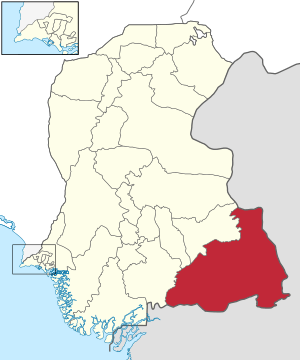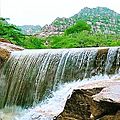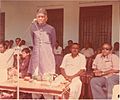Tharparkar District facts for kids
Tharparkar (in Sindhi: ٿرپارڪر, in Urdu: ضلع تھرپارکر) is a special district located in the Sindh province of Pakistan. It is known for its unique desert environment and rich culture. The name "Tharparkar" comes from two words: "Thar," which means desert, and "Parkar," which means "to cross over." This name describes the area well, as it is a place where people often travel across the desert.
Contents
What is Tharparkar?
Tharparkar is a large area in the southeastern part of Sindh. It is mostly a desert, but it also has some green areas, especially after the monsoon rains. The district is home to many different communities, and it has a long history. People in Tharparkar live in small villages and towns. They often rely on farming and raising animals like camels, cows, and goats.
Towns and Areas (Tehsils)
Tharparkar District is divided into smaller areas called tehsils. Think of a tehsil as a sub-district or a smaller region within the main district. Each tehsil has its own main town. Here are the tehsils in Tharparkar:
- Diplo or Deeplo Tehsil
- Chachro Tehsil
- Mithi Tehsil (Mithi is also the main city of the district)
- Nagarparkar Tehsil
Life in the Desert
Life in Tharparkar can be challenging because it is a desert. People often face issues like water shortages, especially when there isn't enough rain. Despite these challenges, the people of Tharparkar are very resilient. They have developed unique ways to live and thrive in their environment.
Water and Farming
Water is very precious in Tharparkar. Most of the farming depends on rainfall, which can be uncertain. When it rains, the desert transforms into a green landscape, and farmers can grow crops like millet and sorghum. People also dig wells to get underground water for drinking and for their animals.
Animals and Wildlife
Tharparkar is home to many interesting animals that have adapted to desert life. You can find different types of birds, reptiles like snakes, and various mammals. The Tharparkar cattle breed is very famous. These cows are strong and well-suited to the desert climate. They are known for their milk and for being good for farm work.
Tharparkar Cattle: Life Cycle and Importance
The Tharparkar cattle are a special breed of cows. They are known for being very hardy and able to survive in tough desert conditions. They have a strong build and are often white or grey. These cows are important for the local people because they provide milk, and their male calves grow into strong oxen used for farming and pulling carts. Their ability to find food and water in dry areas makes them very valuable to the communities.
Culture and Traditions
The people of Tharparkar have a rich culture with unique traditions, music, and festivals. Many different groups live here, including Hindus and Muslims, who often live together peacefully.
- Festivals: People celebrate various festivals with great enthusiasm. For example, Teejri (or Teej) is a Hindu festival where special foods like Sattu are prepared.
- Handicrafts: Women in Tharparkar are skilled at making beautiful handicrafts, like the colorful Ralli quilts. They also use traditional spinning wheels, called Charkha, to make thread.
- Transportation: In many parts of Tharparkar, people still use traditional ways of getting around, such as donkey-drawn carts or local chinchi (rickshaws).
Important Places
Tharparkar has several interesting places, including historical sites and religious temples.
- Churrio Jabal: This is a hill where the Churrio Jabal Durga Mata Temple is located. It is an important religious site.
- Gori Temple: This ancient Jain temple is famous for its beautiful frescoes (wall paintings). These frescoes are some of the oldest Jain frescoes known in the world.
- Ashrams: There are also spiritual centers like Parbrahm Ashram and Sant Nenuram Ashram, which are important for the local communities.
- Gadi Bhit: This is a monument in Mithi that offers a nice view of the area.
Challenges and Efforts
Tharparkar faces some serious challenges, especially related to hunger and malnutrition. Sometimes, due to drought, there isn't enough food or water, which can affect children and families. Many organizations and the government are working to help the people of Tharparkar by providing food, clean water, and healthcare. They are also trying to improve farming methods and build better infrastructure like schools and roads.
Images for kids
-
A type of crown flower, known locally as Ak, growing in Tharparkar.
-
Sparrows in Tharparkar
-
An Indian robin in Tharparkar
-
Hunger and malnutrition are the biggest issues in Tharparkar. Each year, around 1,500 children die in the district.
-
Thari woman working on a Charkha (spinning wheel)
-
Local chinchi (rickshaw) transportation
-
Sattu is prepared for Teejdi (or Teej) festival
-
Tharparkar cattle famous since first World War






























